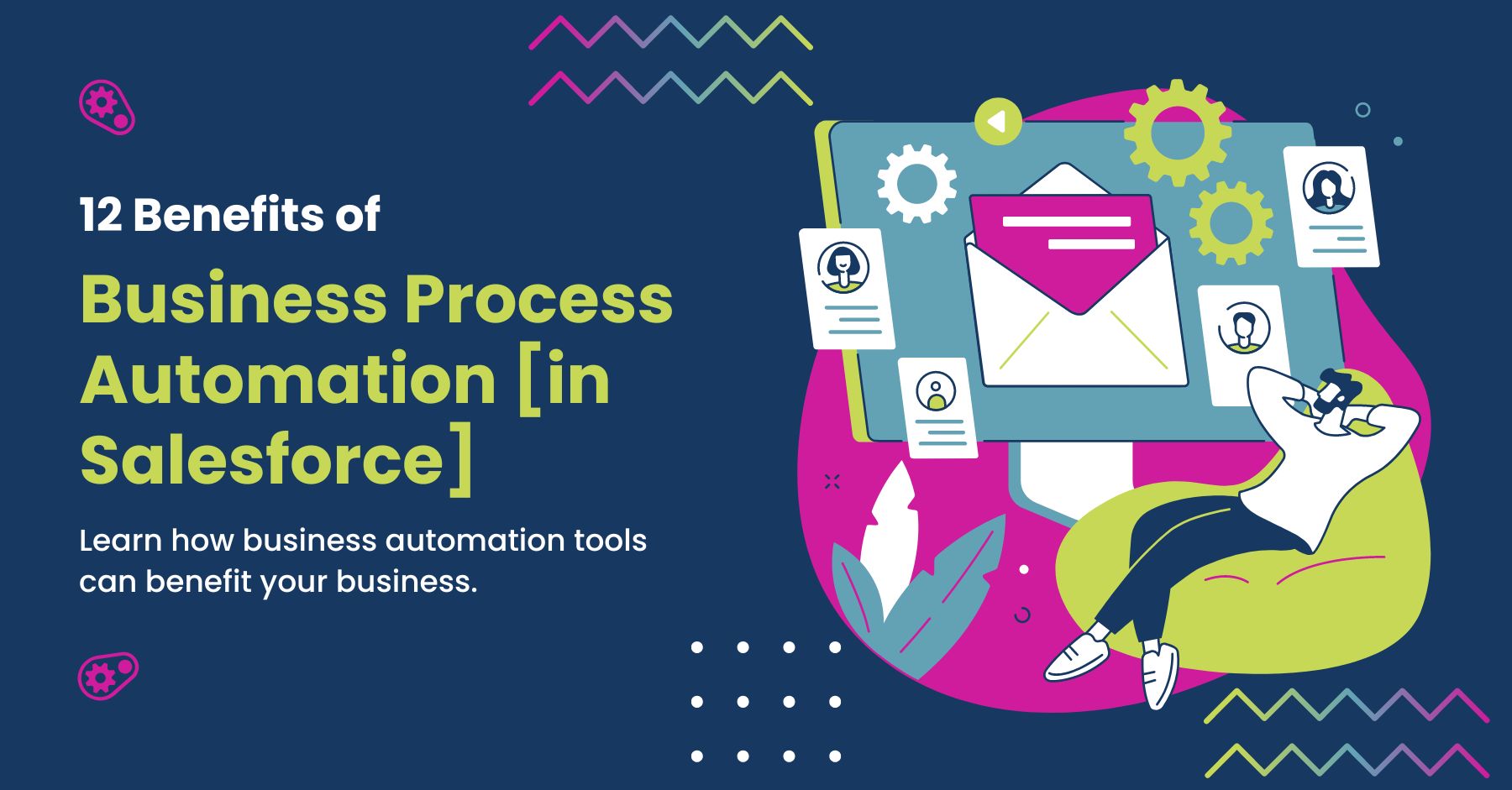Despite all the early-2000s hype, robots and AI have yet to take over the majority of our jobs. However, you may not realize how far automation technology has developed. Many time-consuming, tedious business processes can now be easily automated – using systems you may already have.
Ready to learn what “BPA” is in its simplest form, the types of processes you should consider automating in Salesforce, and the significant benefits of business process automation for your business? Read on.
What is business process automation?
Business process automation (BPA) is assigning repetitive administrative tasks to automated systems rather than doing them manually. A simple example is an automatic email reply. You customize the response and set specific rules, and then your mail system automatically sends an acknowledgment email to designated senders without further action on your part.
You may not realize just how much time employees spend on tasks that could easily be automated. Monotonous tasks can sap your staff’s energy and drag down the quality of their work. On the contrary, automating tedious tasks has the potential to boost morale, increase productivity, and improve accuracy.
What types of business processes can you automate?
Any business process that is well-defined and repeatable can be automated. Some examples include:
- Social media management: Social media automation tools can schedule and post updates, link to content, advertise products, share pictures, and more.
- Project and case management: Use automated workflows to keep track of deadlines, notify team members of upcoming steps in the process, and compile documentation.
- Customer service integration: Integrating your website with your customer management system allows team members to access every piece of contact information they need.
- Accounts payable and receivable: Many accounting tasks can be entirely or at least partially automated.
- Inventory management: Integrating your systems and automating your inventory management shows you the most current picture of what you have, what you need, what you’ve ordered, and what’s on deck.
- Compliance: Companies in industries required to compile regular reports can often benefit from automation, reducing prep time and improving the accuracy of the data.
Tools have become so advanced that they can even automate many processes that require logical thinking and adaptability. Artificial intelligence, analytics, and decision support systems can equal or exceed human performance in many areas.
What about business process automation in Salesforce?
Salesforce customer relationship management (CRM) software and applications focus on sales, customer service, marketing automation, analytics, and application development. One of Salesforce’s best features is its customizability. Organizations can easily customize CRM workflows to automate many tasks.
CRM automation focuses on managing leads and customer relationships. Generally, CRM workflow automation deals with entire processes (strings of tasks) rather than discrete tasks. For example, if you’ve integrated your WordPress website with your Salesforce CRM, you can create an automated workflow that:
- Gathers data entered by a lead into a website form
- Inputs that data into your CRM, creating a customer profile
- Generates a coupon and sends it via email to the lead
- Follows up with an email or text
- Targets social media advertising
- Correlates analytics data related to further interactions into their profile (email opens, visits to your website, interactions with social media posts, etc.)
In the past, individual account representatives needed to manage these leads, but most of these actions don’t require (or benefit tremendously from) a human touch. Automating processes can free up your employees’ time to connect with your customers on a more personal and meaningful level.
What are the benefits of business process automation?
Automating your business processes has many benefits, both tangible (saving money and time) and intangible (improving staff morale, increasing goodwill, and building a better brand). Some of the most significant benefits of business process automation are as follows.
1. Save time.
Automating business processes saves time – that’s a given. On the front end, it frees up your employees to do more complex tasks. On the back end, it reduces mistakes and the time it takes to fix them later.
2. Increase ROI.
Integrating your Salesforce CRM data allows you to efficiently target your customer service, marketing, and sales efforts. For example, let’s say you provide heating and cooling services nationwide. You can target website ads to show solar energy solutions to customers located in the southwest while presenting ads for energy-efficient heat pumps to customers in Minnesota. Every dollar you spend on advertising is more valuable because it’s more likely to result in a conversion.
3. Standardize processes.
Automate specific routine processes like importing business cards into Salesforce, creating new contacts in your CMS from website forms, and updating customer information across your systems. This reduces redundant data, making your communications more efficient and helping to keep your data clean.
You can also standardize workflows to reduce errors and oversights, such as automatically populating, compiling, and generating compliance reports regularly. Here are a couple of other examples:
- Automate follow-up communications to customers to remind them to re-order products or renew subscriptions.
- Calendar a series of deadlines, follow-up appointments, or refills after a triggering event.
Almost any process that involves multiple, predictable steps can benefit from being automated and put on a standardized schedule.
4. Minimize errors.
Transferring data, calendaring follow-ups, and routing communications are administrative tasks that have high error potential. Misspelled names, outdated addresses, and incorrect information can lead to confusion, missed opportunities, and loss of goodwill. Automating business processes can minimize these errors at all steps along the way.
5. Maximize resources.
Make the best use of your people (and save paper) by setting up automated workflows for repetitive tasks. For example…
- You can automate bill paying so your accounting team can focus on collecting outstanding invoices.
- Automate supply reordering to save your office manager time so they can keep your workplace running smoothly.
- Automate first-level customer service responses to ensure leads get immediate answers without having your support team working around the clock.
- Use an automation plug-in to plan and schedule a series of blog and social media posts rather than wasting time every day interacting with multiple platforms.
6. Nurture leads more effectively.
Potential customers will move on quickly if you don’t promptly respond to inquiries. Automating CRM workflows allows you to respond faster and more personally. You can then use sales intelligence tools to provide your sales teams with structured data and insights, helping to customize the sales experience for each lead.
7. Personalize the customer journey.
Business automation can personalize the customer journey in many ways. Integrated analytics can provide customized customer recommendations based on their interactions with your website, past purchases, demographic information, and more. The more relevant your interactions are, the more likely consumers are to do business with you in the future.
8. Gain a competitive advantage.
CRM automation can make it easier for customers to reorder products, upgrade equipment, purchase additional services, and more by targeting communication. Reminding customers that they may be running out of your product and enabling “1-click re-ordering” can significantly enhance sales. Even automation as simple as carrying over a shipping address (“use the same address for billing?”) or previous order history saves customers time and hassle – increasing their loyalty to your business.
9. Keep people happy.
Integrating your Salesforce CRM data with automated workflows can save your employees and clients time and headaches. Avoid shotgun-style, one-size-fits-all approaches that are no longer effective. Here are some ideas:
- You can automatically route customer service issues to the correct department based on a client’s purchasing history.
- Send targeted marketing messages based on past interactions and demographic analysis to move contacts further down the buyer’s journey.
10. Boost productivity.
For every meeting-that-could’ve-been-an-email, there’s a manual admin task that could be a workflow.
- Are you scheduling a meeting for your whole department? Automate a process that checks everyone’s calendars to determine a block of time where most attendees are free.
- Want to follow up with customers to get feedback? Automate reminders to your sales staff to perform in-person check-ins a certain amount of time after a purchase is made.
Taking administrative tasks off your team’s to-do list frees them to be more productive. Plus, most people don’t relish calendaring reminders. Taking responsibility off their plate can boost job satisfaction.
11. Scale your business.
Doing administrative tasks manually means as the workload increases, the demand for resources increases. One of the benefits of BPA is that a workflow can scale up or down without significantly changing its demands. For example, automating customer email updates (and integrating them with your CRM customer contact data) means an email can be scheduled to go to ten or ten thousand customers with essentially the same amount of oversight.
12. Connect departments.
Nothing is more frustrating to a customer than having to provide their information or explain the same problem multiple times. CRM integration and automation ensure that every customer service provider in every department has immediate access to the customer’s purchase history, archived communication, and buyer profile analytics.
Automation Tools in Salesforce
Salesforce provides a robust set of business automation tools to save your business time and resources.
- Workflows are the basic building blocks of business automation. They operate on “if…then” criteria. For example, if a new lead enters a Texas mailing address, the workflow sends a Texas-specific newsletter to their entered email address.
- Flow Builder can help automate most of your organization’s repetitive business processes. Its easy-to-use interface allows users to build customized workflows – without writing code! Its point-and-click business automation tool makes programming experience unnecessary.
- Process Builder lets you easily automate standard business operational tasks like emails and record updates. You can build many more “choose your own adventure” type outcomes than you could with a basic workflow that links one action to one outcome. You can configure Process Builder to launch Flows, trigger processes, and execute quick actions like call logging.
- Approvals allow you to automate more complicated processes by specifying a sequence of steps required to approve a record and perform an action. These can be handy for processes that are essentially administrative but require multiple criteria to be met, such as authorizing access, clearances, or expenses.
Reap the Benefits of Business Process Automation in Salesforce
Ready to talk to a Salesforce consultant about how business automation tools can benefit your business? The crew at Port & Starboard has the skills and savvy to help you navigate the journey and open up exciting new worlds. Contact us to learn more!





